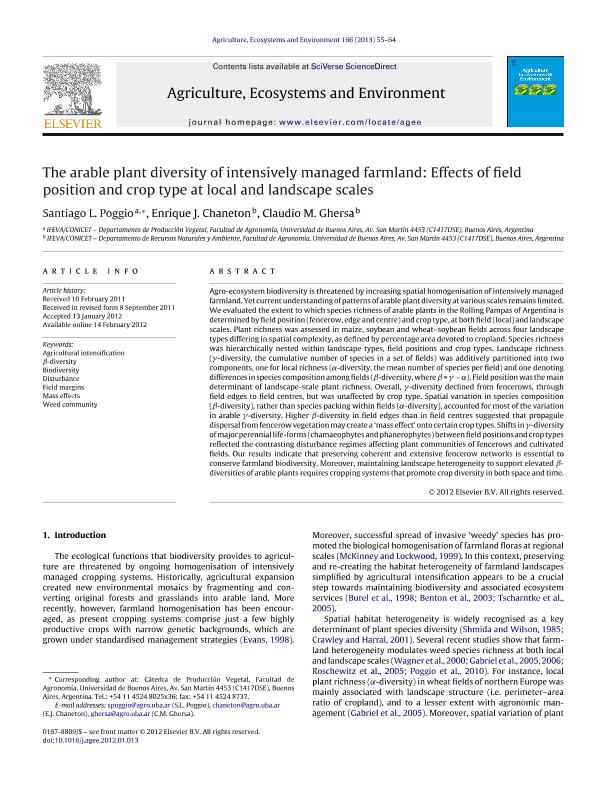Artículo
The arable plant diversity of intensively managed farmland: effects of field position and crop type at local and landscape scales
Fecha de publicación:
14/02/2013
Editorial:
Elsevier
Revista:
Agriculture, Ecosystems and Environment
ISSN:
0167-8809
Idioma:
Inglés
Tipo de recurso:
Artículo publicado
Clasificación temática:
Resumen
Agro-ecosystem biodiversity is threatened by increasing spatial homogenisation of intensively managed farmland. Yet current understanding of patterns of arable plant diversity at various scales remains limited. We evaluated the extent to which species richness of arable plants in the Rolling Pampas of Argentina is determined by field position (fencerow, edge and centre) and crop type, at both field (local) and landscape scales. Plant richness was assessed in maize, soybean and wheat–soybean fields across four landscape types differing in spatial complexity, as defined by percentage area devoted to cropland. Species richness was hierarchically nested within landscape types, field positions and crop types. Landscape richness (γ-diversity, the cumulative number of species in a set of fields) was additively partitioned into two components, one for local richness (α-diversity, the mean number of species per field) and one denoting differences in species composition among fields (β-diversity, where β = γ − α). Field position was the main determinant of landscape-scale plant richness. Overall, γ-diversity declined from fencerows, through field edges to field centres, but was unaffected by crop type. Spatial variation in species composition (β-diversity), rather than species packing within fields (α-diversity), accounted for most of the variation in arable γ-diversity. Higher β-diversity in field edges than in field centres suggested that propagule dispersal from fencerow vegetation may create a ‘mass effect’ onto certain crop types. Shifts in γ-diversity of major perennial life-forms (chamaeophytes and phanerophytes) between field positions and crop types reflected the contrasting disturbance regimes affecting plant communities of fencerows and cultivated fields. Our results indicate that preserving coherent and extensive fencerow networks is essential to conserve farmland biodiversity. Moreover, maintaining landscape heterogeneity to support elevated β-diversities of arable plants requires cropping systems that promote crop diversity in both space and time.
Archivos asociados
Licencia
Identificadores
Colecciones
Articulos(IFEVA)
Articulos de INST.D/INV.FISIOLOGICAS Y ECO.VINCULADAS A L/AGRIC
Articulos de INST.D/INV.FISIOLOGICAS Y ECO.VINCULADAS A L/AGRIC
Articulos(OCA PQUE. CENTENARIO)
Articulos de OFICINA DE COORDINACION ADMINISTRATIVA PQUE. CENTENARIO
Articulos de OFICINA DE COORDINACION ADMINISTRATIVA PQUE. CENTENARIO
Citación
Poggio, Santiago Luis; Chaneton, Enrique Jose; Ghersa, Claudio Marco; The arable plant diversity of intensively managed farmland: effects of field position and crop type at local and landscape scales; Elsevier; Agriculture, Ecosystems and Environment; 166; 14-2-2013; 55-64
Compartir




